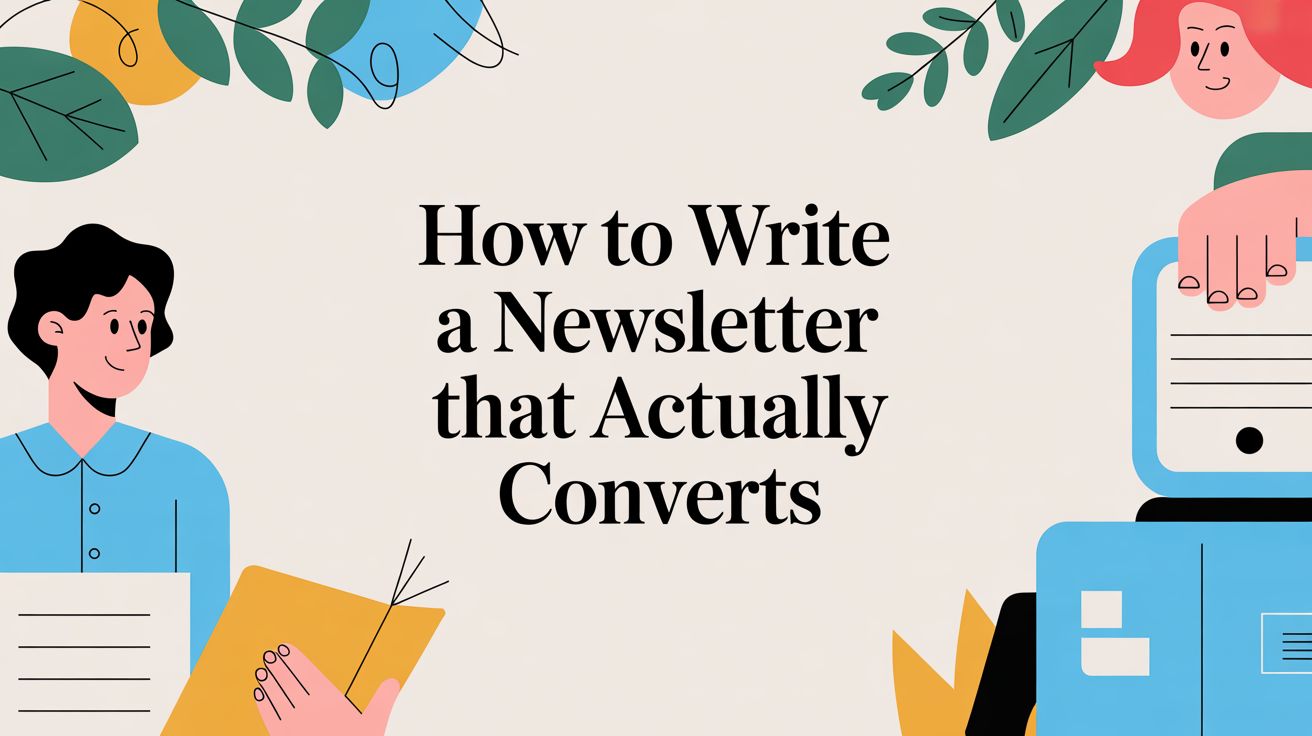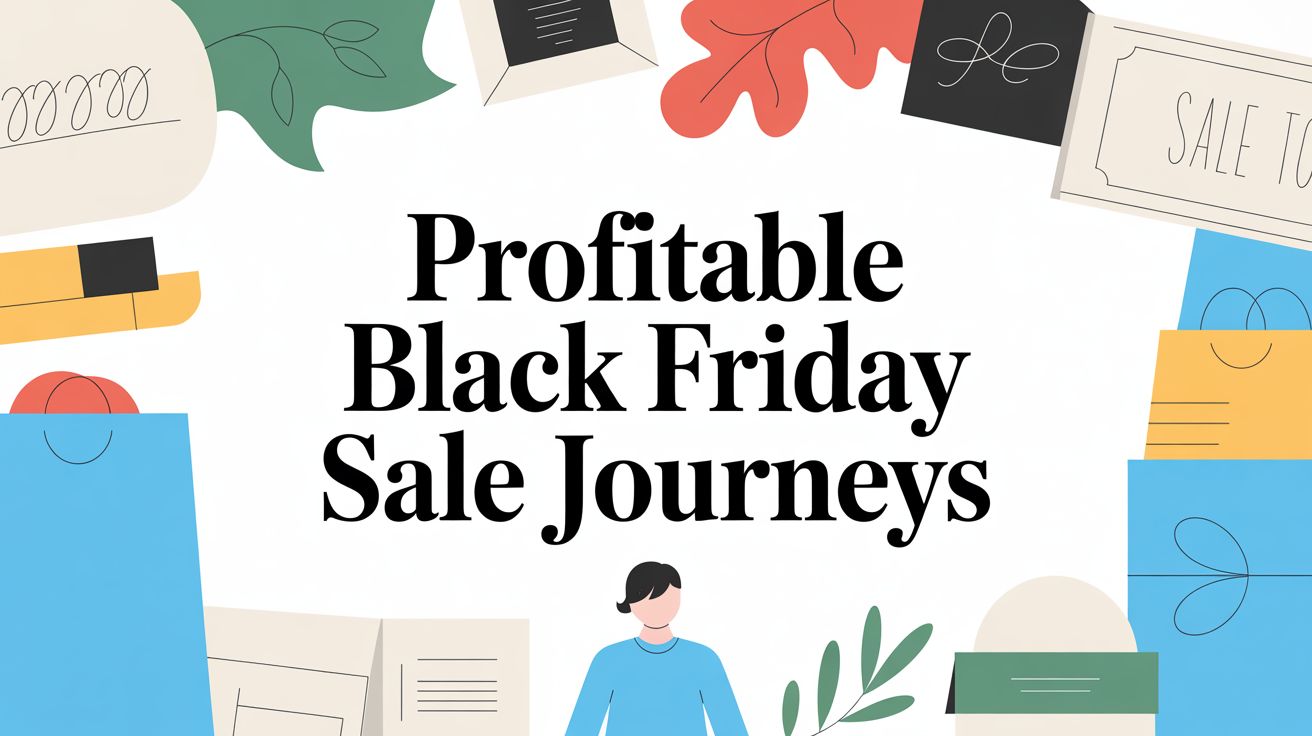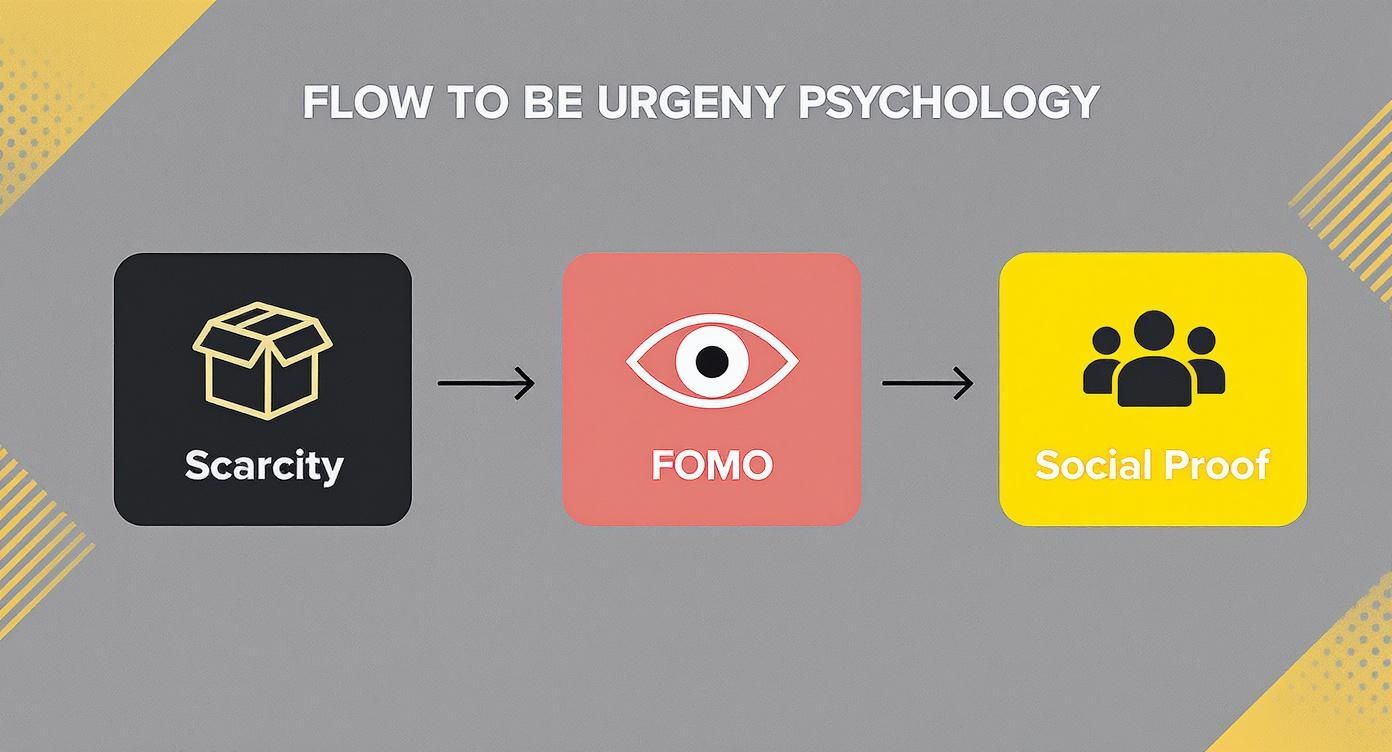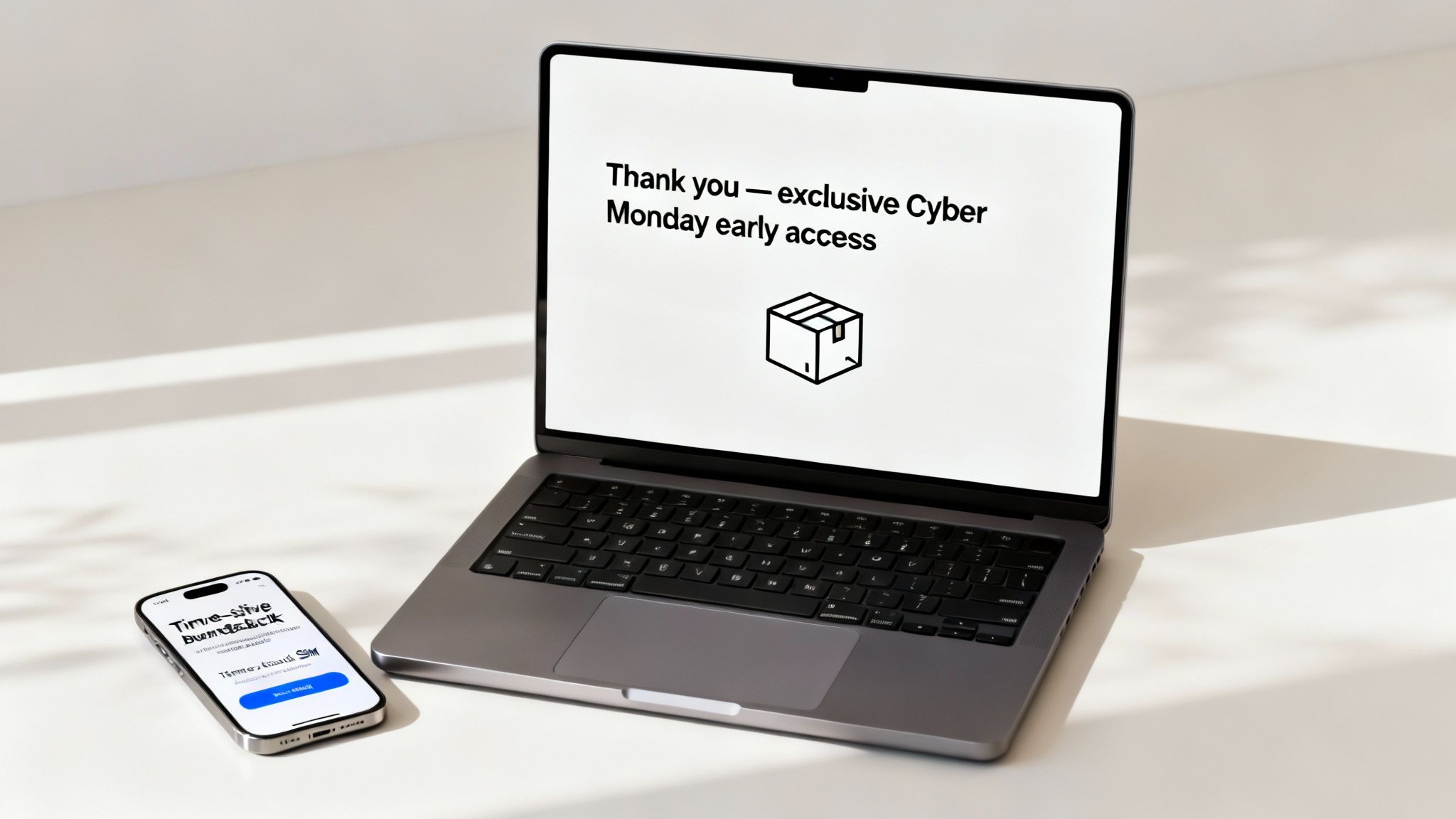
Profitable Black Friday Sale Journeys

A successful black friday sale journey isn't just about slapping a discount on your homepage. It is a carefully architected experience, grounded in consumer psychology, designed to guide a customer from casual browsing to a confident purchase.
True success means moving beyond basic countdown timers. It requires a sophisticated strategy rooted in behavioral science—one that builds genuine excitement, drives high-intent sales, and, most critically, protects your profit margins.
Beyond the Countdown: The Science of Urgency
The holiday shopping season is no longer a single-day sprint; it's a multi-week marathon. Global online sales on Black Friday alone hit a staggering $74.4 billion, with mobile commerce dominating. In the U.S., over 54% of all Black Friday sales now happen on a phone, underscoring the massive scale of the opportunity.
In such a crowded market, simply displaying a ticking clock on your Shopify store is insufficient. Shoppers have become desensitized to generic timers, which now function as background noise. Without a deeper psychological anchor, they lack impact. This is where modern urgency marketing, the kind rooted in behavioral economics and expertly deployed through platforms like Quikly, provides a significant competitive advantage.
Moving From Pressure to Persuasion
The pivotal shift is from manipulation to persuasion. A fake timer creates artificial pressure and can damage brand credibility. Authentic urgency, on the other hand, provides valuable context that empowers a customer to make a decision, positioning the brand as a helpful guide.
This isn't about tricking someone into a purchase. It's about framing an offer in a way that aligns with natural human decision-making processes, as outlined in numerous consumer psychology studies.
It all comes down to a few key psychological principles:
- Scarcity: Highlighting limited product availability or exclusive access. Research in behavioral economics shows that when an item is perceived as rare, its value increases in the consumer's mind, making it a far more powerful motivator than a generic discount.
- Fear of Missing Out (FOMO): This powerful emotional trigger activates when shoppers perceive a valuable opportunity that is fleeting. It taps into the principle of loss aversion, where the pain of losing something is psychologically more powerful than the pleasure of gaining something of equal value.
- Social Proof: Nothing alleviates purchase anxiety more effectively than seeing others are buying and enjoying a product. Notifications like, "25 people have bought this in the last hour," serve as validating signals for hesitant shoppers, a concept widely documented in consumer behavior research.
- Anticipation: The most sophisticated brands begin building excitement before a sale begins. Early access sign-ups and teaser campaigns create a sense of community and exclusivity, making the eventual offer feel like a rewarding event.
Actionable Takeaway: By grounding your banners, popups, and messaging in these scientifically-backed triggers, you can design Black Friday sale journeys that feel like an exclusive event, not a clearance sale. This builds a narrative that creates real excitement while protecting your ROI.
The Financial Impact of Psychological Triggers
Applying these principles directly impacts your bottom line. Instead of running a site-wide 30% discount that erodes margins, you can use targeted urgency to drive sales on specific, high-margin products. This approach helps you maintain a much healthier Average Order Value (AOV) and protect overall profitability.
You can explore these core principles in our guide on the psychology of urgency marketing.
For merchants on Shopify Plus, this is where the strategy becomes truly powerful. The ability to automate and segment these psychological triggers for different customer groups—like showing a special "low stock" banner only to returning VIPs—transforms your site from a static storefront into a dynamic sales engine that reacts to individual shopper behavior.
That is the foundation of a modern, profitable Black Friday strategy.
Building Pre-Sale Anticipation and Buzz
A high-ROI Black Friday sale journey does not begin on Black Friday. The foundational work begins weeks, sometimes months, in advance. This pre-sale phase is where you transform a cold audience into a high-intent list of consumers genuinely excited to buy the moment your sale launches.
This isn’t about sending a generic "sale is coming soon" email. It's a calculated strategy to build anticipation so powerful that you generate a massive, profitable traffic spike at launch. This secures a burst of early sales and drives down your customer acquisition cost (CAC) during the most expensive advertising period of the year. You are not fighting for attention; you are activating an audience you have already cultivated.
Cultivating an Engaged Audience
First, create an environment of exclusivity. Basic pop-ups asking for an email in exchange for a newsletter subscription are outdated and focus on list growth over revenue. Today's leading brands create dedicated sign-up experiences for "VIP Early Access" or a "Secret Black Friday List." This simple linguistic shift changes the dynamic from a marketing opt-in to an invitation to an exclusive club.
The moment someone signs up, the journey truly begins. A seamless integration with your email and SMS platforms, like Klaviyo, is critical.
- Immediate Segmentation: As soon as a user opts in for early access, they should be automatically tagged in your ESP. For a Shopify Plus merchant, this could be a specific tag like "BFCM-VIP-2024," enabling highly targeted messaging.
- Teaser Campaigns: Initiate a drip campaign that hints at deals without revealing everything. Showcase silhouettes of new products, share behind-the-scenes videos of your team preparing for the launch, or run polls asking followers what they hope to see on sale.
- Tiered Access: Reward engagement by creating different access tiers. For instance, shoppers who open every email or click through on every SMS could be moved into an even more exclusive group that gains access 30 minutes before the main VIP list.
This approach transforms your email list from a passive database into an active, engaged community. We dive deeper into these tactics in our guide on the core ingredients of consumer anticipation.
This entire process is about tapping into core psychological principles to build that pre-sale excitement.

By weaving together scarcity, FOMO, and social proof, you start crafting a narrative that positions your sale as a can't-miss event.
To help visualize how these elements come together across the entire campaign, here is a breakdown of each phase.
Black Friday Journey Phase Comparison
This table shows how goals, psychological drivers, and tactics evolve from building buzz to closing sales.
| Journey Phase | Primary Goal | Key Psychological Trigger | Actionable Tactic |
|---|---|---|---|
| Pre-Sale Buzz | Build a high-intent list and generate revenue | Exclusivity & Anticipation | A "VIP Early Access" sign-up campaign with teaser emails and SMS messages. |
| Sale Launch | Drive a massive initial sales spike | Urgency & Scarcity | A time-sensitive early bird offer exclusively for the VIP list. |
| During the Sale | Maintain momentum and maximize AOV | Social Proof & FOMO | Displaying "X people are viewing this" or real-time sales notifications on product pages. |
| Final Hours | Convert procrastinators | Loss Aversion | "Last chance" countdown timers in emails, SMS, and on-site banners. |
Each phase has a distinct objective, building on the last to create a seamless and persuasive customer experience.
Beyond Basic Sign-Ups
To truly differentiate, you must move beyond simply collecting emails. The end goal is revenue, not just a larger list. A platform like Quikly can gamify the pre-launch window, rewarding the fastest responders to a notification with the best deals. This does more than build a list; it trains your audience to act decisively when it matters most.
Actionable Takeaway: A sophisticated pre-sale strategy is your best defense against margin erosion. By building a high-intent audience before the sale, you create predictable revenue and reduce your reliance on expensive, last-minute advertising. This is a shift from revenue capture to revenue generation.
Consider the difference. A basic pop-up collects an email for a generic 10% off. An advanced, psychology-driven approach creates a multi-layered event where customers feel genuinely rewarded for their loyalty, making them far more likely to convert—with a higher Average Order Value (AOV)—when the sale begins.
Crafting a Dynamic Live Sale Experience
The moment your Black Friday sale goes live, the dynamic shifts. The anticipation you've built culminates in a flood of traffic. However, static banners and site-wide discounts quickly become ineffective background noise. To convert that surge of visitors into revenue, you need an experience that adapts in real-time to each shopper's unique black friday sale journey.
This is where sophisticated, behavior-triggered urgency moves from a theoretical concept to a direct driver of ROI.

This is not about generic countdown timers that treat every visitor identically. It is about deploying intelligent automation that understands individual user intent and responds with the perfect psychological nudge at the opportune moment. This approach is grounded in how people actually shop, recognizing that different shoppers require different motivations.
Personalizing Urgency With Behavioral Triggers
Instead of a one-size-fits-all strategy, envision a storefront that personalizes its urgency cues for every visitor. This is the next evolution of e-commerce marketing, where sophisticated automation handles the complex task of real-time personalization.
Here are practical examples of this in action:
- View-Based Scarcity: A shopper has viewed the same product three times in the last ten minutes. A basic site does nothing. A smart site, however, automatically triggers a low-stock alert on that product page, stating "Only 7 left!" This is a direct, helpful response to their demonstrated interest, leveraging the principle of scarcity.
- Segment-Specific Social Proof: On Shopify Plus, customer tags are a valuable asset. You can configure your system to show different social proof messages based on these tags. A first-time visitor might see, "Over 500 sold this week!" while a returning VIP with a high lifetime value receives a more exclusive nudge like, "A VIP favorite - selling fast!"
- Cart-Value-Based Incentives: A shopper's cart total is just $10 from your free shipping threshold. Instead of a static header bar, a dynamic pop-up appears: "You're so close! Add one more item to unlock free shipping before our timer runs out." It combines a clear incentive with time-based urgency.
These are not flashy tricks; they are targeted interventions designed to overcome specific friction points in the buying process. The goal is to provide helpful, timely information that helps a customer make a confident purchase decision—a world away from the manipulative pressure of a fake timer.
Actionable Takeaway: Match the intensity and type of urgency to the customer's demonstrated level of intent. A casual browser receives a gentle nudge, while a high-intent shopper gets a clear and compelling reason to act now.
Protecting Profit Margins With Smart Automation
One of the biggest risks of Black Friday is margin erosion. Blanket discounts drive volume but can decimate profitability. Dynamic, behavior-triggered urgency is a primary tool for protecting those margins.
This approach allows you to apply targeted pressure to convert shoppers who are already close to buying, rather than offering discounts to those who would have purchased anyway.
A 20% sitewide discount impacts every sale. A targeted "low stock" alert, however, might only be shown to 15% of your visitors—the ones most engaged and likely to convert. This surgical approach helps maintain a higher Average Order Value (AOV) and protects your bottom line.
This strategy extends beyond your website. Integrating these real-time triggers with other marketing channels creates a cohesive experience. Platforms like Quikly connect these on-site "Moments" with your email and SMS tools. For instance, a social proof notification performing well on your site can be repurposed into a compelling social media ad. For a deeper dive, you can explore how urgency marketing can help boost your social media.
This level of sophisticated automation is what separates high-growth brands from the rest. It’s about building a system that doesn't just display offers, but actively works to turn browsers into buyers—all while keeping your business profitable.
Protecting Margins with Strategic Scarcity
Urgency marketing is more than a sales booster; it's a strategic tool for inventory management and, crucially, profitability. The classic Black Friday mistake is implementing a massive, site-wide discount. While it moves products, it can demolish profit margins. The objective isn’t just selling more—it’s selling smarter by protecting your average order value (AOV) and the overall financial health of your business.
This means avoiding the race to the bottom. Instead of a blanket 30% off sale that devalues every purchase, use scarcity in a more calculated way. This allows you to move specific products, clear out aging inventory, and drive revenue on your own terms.
From Blanket Discounts to Surgical Strikes
The key is to view inventory management not as a logistical chore but as a proactive revenue-generating activity. Every e-commerce brand has overstocked items or products nearing the end of their lifecycle. These can be transformed into high-energy sales events rather than relegated to a clearance page.
This is where you can leverage behavioral economics. A "flash event" for an overstocked product, positioned as a fleeting opportunity, is perceived as far more valuable to a shopper than a simple markdown.
Here’s how to put this into practice:
- Overstock Flash Events: For an overstocked product, build a dedicated, time-sensitive campaign. Announce a "24-Hour Flash Drop" for that specific item to your email and SMS lists. This focuses customer attention and creates a significant burst of sales without devaluing other products.
- "Last Chance" Lifecycle Campaigns: For products being phased out, create a "Last Chance to Buy" journey. This taps into loss aversion—the psychological principle where the fear of missing an opportunity is a stronger motivator than the pleasure of gaining a deal. A message like, "Gone forever after midnight," is infinitely more powerful than a clearance tag.
- Collection-Specific Drops: Instead of discounting your entire catalog, launch a series of targeted "product drops" for different collections over the BFCM weekend. This highlights various product lines and creates multiple waves of excitement, keeping your audience engaged for days.
Actionable Takeaway: A series of targeted, psychology-driven drops will always outperform a single, generic site-wide discount in terms of profitability. You maintain control, protect your brand's perceived value, and turn inventory management into a strategic marketing weapon.
The ROI of Controlled Scarcity
This surgical approach directly impacts your bottom line. By avoiding deep, store-wide discounts, you protect your AOV and ensure sales are profitable. It transforms Black Friday from a margin-eroding necessity into your most strategic revenue event of the year.
If you are a Shopify Plus merchant, you can take this further. Use customer tags from a platform like Klaviyo to offer these flash events exclusively to specific segments—such as customers who have previously purchased a related product. This creates a highly relevant offer with a strong likelihood of conversion.
Driving this much focused traffic also requires robust security. While strategic scarcity boosts sales, it's critical to protect that revenue from fraudulent activity. Learning about blocking fraudulent customers on Shopify is essential to safeguarding your earnings.
Ultimately, this is what separates basic countdown timers from sophisticated urgency marketing. A simple clock adds pressure. A strategic scarcity campaign, powered by a platform like Quikly, is an automated system designed to solve real business problems—like clearing inventory and protecting margins—while creating a genuinely engaging experience for your customers. It’s about using psychology as a tool for building a healthier, more profitable business.
Extending the Journey After the Purchase
You have made the sale. Excellent. But a successful Black Friday sale journey does not end at checkout. The moments immediately following a purchase are among the most powerful for converting a one-time holiday deal-seeker into a loyal customer.
The dopamine from securing a great deal is still fresh, and their trust in your brand is at an all-time high. This is your prime window to continue the conversation and significantly increase that customer's lifetime value (LTV).
Too many brands go silent post-transaction, missing a massive revenue opportunity. The goal is immediate re-engagement, using the momentum from the first purchase to secure the next. This isn't about being pushy; it's about providing timely, exclusive value that shows appreciation and makes them feel like an insider.

From One-Time Buyer to Loyal Customer
The post-purchase phase is where smart automation and psychology can deliver exceptional results. Replace the generic "thank you for your order" email with targeted campaigns that feel personal and exclusive. For building lasting relationships, mastering customer journey optimization is essential.
Here are two actionable tactics:
- Exclusive Cyber Monday Early Access: This highly effective tactic rewards new buyers. If you have Shopify and Klaviyo integrated, you can immediately tag anyone who purchased on Black Friday. Then, send an email or SMS granting them exclusive early access to your Cyber Monday deals as a thank you. This leverages the principle of reciprocity and makes them feel valued.
- Time-Sensitive Bounce-Back Offers: Follow up with a compelling offer that has a deadline. For example: "Thanks for your order! As a new VIP, unlock 20% off your next purchase in the next 48 hours." This urgency encourages a quick second purchase, which can dramatically boost their LTV from day one.
Actionable Takeaway: The psychology is simple: a customer who has just purchased has already overcome the friction of a first-time transaction. They are primed to buy again if given a compelling reason. The post-purchase window is your best opportunity to secure that second sale.
Retargeting the Almost-Buyers
Not every cart converts. The industry benchmark for cart abandonment hovers around a staggering 70%. This represents a huge pool of high-intent individuals who were one click away from purchasing. The days following Black Friday are the perfect time to win them back.
Forget generic "you left something in your cart" ads. Deploy dynamic retargeting that reinstates the initial urgency. Your ads should not only show the product they left behind but also remind them that the deal is expiring.
A message like, "The Black Friday price on your [Product Name] is about to disappear forever" is far more impactful than a simple product reminder.
This sophisticated, automated follow-up distinguishes high-growth brands. Basic pop-up apps focus only on pre-sale email capture. A true urgency marketing platform like Quikly helps manage the entire customer lifecycle—from building pre-sale hype with its "Moments" to re-engaging cart abandoners and nurturing new customers post-purchase. It is a complete system designed to maximize revenue at every stage of the Black Friday journey.
By continuing the conversation, you don't just make a sale; you build a relationship.
Your Black Friday Journey Questions Answered
We have covered the strategy, from building pre-sale buzz to post-purchase follow-up. Now, let’s address some of the most common questions about implementing these advanced Black Friday sale journeys.
Is Urgency Marketing Just Manipulative Pressure?
This distinction is critical. Basic tactics like a fake countdown timer that resets on page refresh are indeed manipulative and can erode customer trust.
Sophisticated urgency marketing, however, is not about deception; it is grounded in transparent behavioral psychology. It aligns marketing with a customer’s natural decision-making process. For example, informing a shopper that a popular item is low in stock is not a trick—it is genuinely helpful information that enables an informed choice. The goal is to provide useful context, whether through social proof or a real logistical deadline, that improves the shopping experience. It is the difference between helping someone make a decision and trying to force their hand.
How Is This Different From a Standard Shopify Countdown Timer?
A standard countdown timer from the Shopify App Store is a blunt instrument. It is a one-size-fits-all tool that displays the same timer to every visitor, regardless of their identity or on-site behavior.
A modern urgency platform creates dynamic, personalized experiences. It is more than a timer; it uses behavioral triggers to launch specific marketing "Moments." It might display a low-stock alert pulling from real-time Shopify inventory data, drop a flash sale exclusively for customers tagged as 'VIPs,' or show a social proof banner only to returning visitors. Think of it as an automated marketing engine that reacts to individual shopper behavior, not just a static visual element. This is the key difference between basic apps focused on simple triggers and an advanced platform like Quikly, built for sophisticated automation and revenue generation.
The core difference is intelligence. A basic timer is static. An advanced urgency journey is dynamic, personalized, and automated, turning your website into a responsive sales environment.
What Metrics Should I Track for a Profitable Black Friday?
While conversion rate is important, it doesn't provide the full financial picture. To determine if your campaign was truly profitable, focus on these metrics:
- Revenue Per Visitor (RPV): This should be your north star metric. It provides the clearest indicator of how much revenue each visitor is generating and whether your strategies are effective.
- Average Order Value (AOV): Monitor this to ensure your urgency tactics are encouraging larger purchases, not just a flood of sales on low-margin items.
- Profit Margin: This is the ultimate bottom line. After all discounts and promotions, did your campaigns protect your margins or erode profits?
- Customer Lifetime Value (LTV): After the campaign, analyze the repeat purchase rate of your Black Friday customers. Did you acquire one-time deal hunters or successfully convert holiday shoppers into loyal, long-term customers?
These metrics provide a complete financial story, helping you measure sustainable growth beyond simple conversion rates.
How Early Should I Plan My Black Friday Sale Journeys?
Planning should begin in late Q2 or early Q3 (July or August). This may sound extreme, but attempting to assemble this in October is a recipe for a generic, margin-killing discount frenzy.
Starting early provides the necessary time to architect the entire experience, from pre-launch hype campaigns to post-purchase follow-up flows. You need a sufficient runway to properly segment your audience, create all necessary assets, set up and test integrations between tools like Shopify and Klaviyo, and build out all automated workflows. The most strategic and profitable campaigns are always built months, not weeks, in advance.
Ready to transform your Black Friday strategy from basic discounts to a high-ROI, psychology-driven experience? Quikly provides the tools to build sophisticated, automated urgency campaigns that captivate customers and protect your profits. See how Quikly can power your most profitable Black Friday yet.

The Quikly Content Team brings together urgency marketing experts, consumer psychologists, and data analysts who've helped power promotional campaigns since 2012. Drawing from our platform's 70M+ consumer interactions and thousands of successful campaigns, we share evidence-based insights that help brands create promotions that convert.
